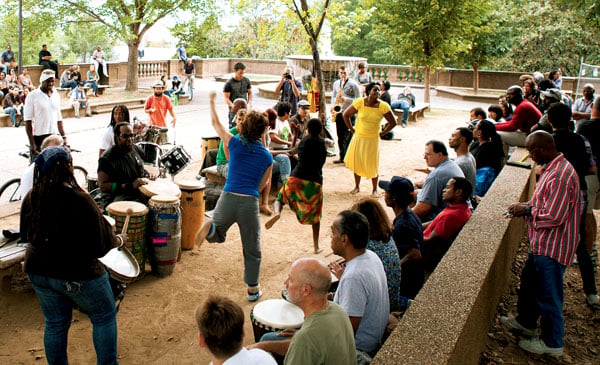Photograph by Yassine El Mansouri
“They’ll come,” Abdel Elgizouli says as rain falls lightly on DC’s Meridian Hill Park. “They’ll come.”
The 56-year-old from Sudan sits alone next to the park’s Joan of Arc statue, where on most warm Sunday afternoons drummers gather. When it rains, they try to wait it out. “Watch,” Elgizouli says, tapping harder. “We’ll call the sun.”
Each week, revelers shed their inhibitions amid the drumming and dancing. Many say the drum circle gives them a spiritual and social lift that’s hard to find anywhere else in Washington.
Anya Blakeley has been coming here from Silver Spring for four years. She says she’s seen attendance double: “It’s like a party of people from all communities and all nations.”
Ileana Olmos and Katherine Jimenez, natives of Panama and Costa Rica, say the event reminds them of their home countries, where people often gather outdoors around music. “There are not a lot of places in DC where you can do something like this,” Jimenez says, “especially without drinking or paying money.”
Meridian Hill sits by three neighborhoods—U Street, Adams Morgan, and Columbia Heights—that have changed a lot, and the drum circle has changed, too. DC resident Heran Sereke-Brhan, who has been coming here for six years, says the crowd has gotten younger and more diverse: “I don’t know why all these different people are drawn here, but the beauty is that they are.”
Some worry that the gathering’s meaning is getting lost. William H. Taft says it exists to honor a storied history of drumming in the African-American community. Taft has been part of the drum circle since 1972 and the event’s sponsor for 15 years.
In the antebellum South, masters banned slaves from banging drums out of a fear they would use the drums to communicate and flee to freedom. After slaves were emancipated in DC in 1862, Taft says, they were given back their African clothing, religious artifacts, and drums and went to two of the higher places in the city—Meridian Hill and Fort Reno—and “drummed and danced to give thanks to God for answering their lifelong prayers to be free.” Today the gathering is a way to honor those ancestors.
During the civil-rights movement of the 1960s, drums brought people together. Drummer Doc Powell recalls marches and protests in Meridian Hill Park. “There would always be some kind of drumming,” he says.
In 1970, activist Stokely Carmichael unofficially renamed the park Malcolm X Park. In 1975, Powell founded the Malcolm X Drummers & Dancers, a performance group devoted to the cultural activities born during the park’s civil-rights heyday. “I just want people to respect the tradition,” Taft says, “and to seek to understand the history of the drum.”
As the neighborhoods around the park have changed, the National Park Service has received complaints about the noise. “It can be loud,” says park-service spokesman Bill Line. “There are homes on all sides and complaints on all sides.”
The drum circle used to be a small gathering of African-Americans, but so many new people have come to the event, Taft says, that crowd control and public safety are concerns. He says anyone who would like to participate should e-mail him at drumcircle.talkindrum@gmail.com to get an application to register his or her drum. Joel Bergner, who has been coming three years, laughs at the noise complaints: “Why would you move somewhere that has this decades-old tradition and expect it to stop because of you?”
As Elgizouli promised, by early evening hundreds of people surround the pulse of the drums. On a nearby green space, people practice yoga and the Brazilian martial art capoeira. Others draw, read, and picnic.
Several drummers help 24-year-old Mike Kayembe, who is deaf. It’s Kayembe’s first time in the drum circle. He follows the lead of their hands. “I feel the rhythms in my heart,” he writes in a notebook. “So, so beautiful.”
“This is the best people-watching in the city,” says 29-year-old Megan Luczko as she sits in the grass on a blanket. She and her boyfriend, Ryan Cocolin, had their second date here on an August evening in 2009. She says the atmosphere helped them shed their inhibitions: It was the night of their first kiss.
Next to Luczko and Cocolin, three women spin hula hoops and giggling children kick a soccer ball. A little farther away, a woman sits in meditation, just feet from the dust and the dancing and the beat of the drums.
Dozens of drummers bang the djembes, timbales, and bongos they brought from home, and dozens of dancers surround the drums. As the people move and the beat pulses, the sun comes out.
“What did I tell you?” Elgizouli laughs. “It can’t rain forever.”
Experience the Drum Circle for yourself with this video:
This article first appeared in the April 2011 issue of The Washingtonian.


















